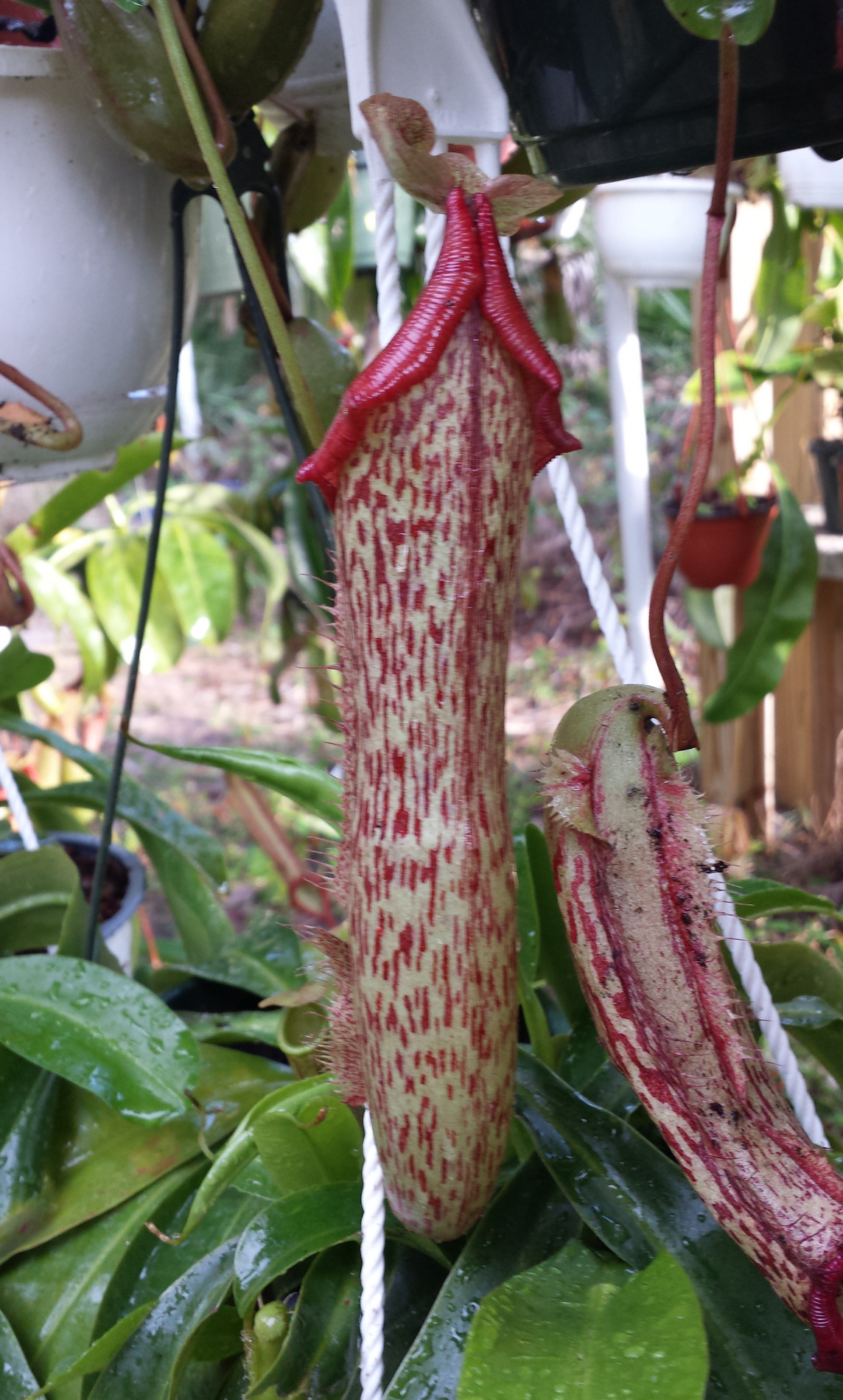This is a miranda pitcher. They produce 30 a year and 12-16 inches long each
Pitcher plants are carnivorous plants whose prey-trapping mechanism features a deep cavity filled with liquid known as a pitfall trap. It has been widely assumed that the various sorts of pitfall trap evolved from rolled leaves, with selection pressure favouring more deeply cupped leaves over evolutionary time. However, some pitcher plant genera (such as Nepenthes) are placed within clades consisting mostly of flypaper traps: this indicates that this view may be too simplistic, and some pitchers may have evolved from the common ancestors of today's flypaper traps by loss of mucilage.
Foraging, flying or crawling insects such as flies are attracted to the cavity formed by the cupped leaf, often by visual lures such as anthocyanin pigments, and nectar bribes. The sides of the pitcher are slippery and may be grooved in such a way so as to ensure that the insects cannot climb out. The small bodies of liquid contained within the pitcher traps are called phytotelmata. They drown the insect, and the body of it is gradually dissolved. This may occur by bacterial action (the bacteria being washed into the pitcher by rainfall) or by enzymes secreted by the plant itself. Furthermore, some pitcher plants contain mutualistic insect larvae, which feed on trapped prey, and whose excreta the plant absorbs.[1] Whatever the mechanism of digestion, the prey items are converted into a solution of amino acids, peptides, phosphates, ammonium and urea, from which the plant obtains its mineral nutrition (particularly nitrogen and phosphorus). Like all carnivorous plants, they grow in locations where the soil is too poor in minerals and/or too acidic for most plants to survive.
After growing lots of house plants you can get bored with the more common ones. This one is sure to catch eyes. This plant is carnivorous. Nepenthes catch bugs and dissolve the bugs in pitchers much as we dissolve food in our stomachs. The pitchers on this guy look large enough to eat very large bugs or even small lizards.
These particular carnivorous plants come from Asia. There are about 100 species in the Nepenthes family. The pitchers form on the ends of leaves, collect a bit of rain water and wait for dinner to arrive. The name Nepethenes comes from Carl Linneaus, and is from the Greek word meaning without pain. According to Homer the pitcher fluid has a highly intoxicating effect. All Asia pitcher plants have the same number of chromosomes making it very easy to cross breed them.
Nepethenes have two main divisions, those that grow in low tropical areas, and those that grow high on the mountains. Miranda is tropical. Both types of nepethenes require high humidity.
Miranda, like the other tropical pitcher plants grows on and under trees. So it does not want or need direct sunlight. The higher growing ones grow at the edges of woods and on mountains and do require lots of light.
Soil should be low in nutrients and acidic. Sphagnum peat moss works well as a potting medium, or a peat moss and soil mixture. The pitcher plants that grow in the mountains prefer a peat moss and sand mixture for potting.
You can and should fertilize this carnivorous plant, but do so lightly and sparingly.
You can put this plant out side in the summer. It needs to be in a shady area if you do that. It MUST be brought back into the house when the temperature nears 50′F. It will not tolerate cold weather. It is extremely cold sensitive.
You want a bright window for this plant, but not direct sun. An east or west window is best. If all your windows are sunny, move it back from the window a bit. It will burn easily. Keep the soil wet and put a little water in each of the pitchers when you water.
The pitchers of nepethenes have three distinct zones. The top’s purpose is to attract prey. This is the lid, the rim of the trap opening, and the inner margin. This area has lots of nectar glands. The rim of the pitcher is ribbed which helps to slide insects into the trap. Some even have fang like ribs. This area also often has scent glands.
Next is the pitfall zone. This begins just beneath the scent glands inside the pitcher. This can usually be seen unaided. It appears waxy and translucent. There are two layers of cells here. The outer layer has crystal like cells that slough off when touched, the inner layer cells are waxy. Together they insure prey falls deep into the pitcher. Over time these cells wear off and in old pitchers prey can sometimes escape.
At the bottom is the digestive area of the pitcher. The digestive glands are located here, larger glands nearer to the bottom. The trap fluid contains all the digestive enzymes and chemicals making the fluid wetter to insure prey gets completely soaked and drowns quickly. As soon as prey has drowned digestion begins. Usually this takes a couple of days. Exoskeletons are partially digested. Rainwater thins out the digestive fluid.



